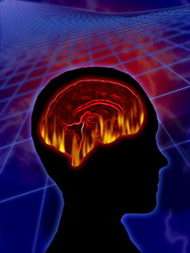Scientists Find 'Aha!' Favors a Prepared Mind

Why do "Aha!" moments sometimes come easily and sometimes not at all? A new study reveals that patterns of brain activity before people even see a problem predict whether they will solve it with or without a sudden insight.
If you’ve experienced the highs and lows of creative thinking, you know that sometimes the creative well is dry, while at other times creativity is free flowing. It is during the latter times that problem solvers often experience so-called “Aha!” moments – those moments of clarity when the solution to a vexing problem falls into place with a sudden insight and one sees connections that previously eluded you.
But why do “Aha!” moments sometimes come easily and sometimes not at all? A new study reveals that patterns of brain activity before people even see a problem predict whether they will solve it with or without a sudden insight, and these brain activity patterns are likely linked to distinct types of mental preparation.
John Kounios, a professor of psychology at Drexel University, Mark Jung-Beeman of Northwestern University, and their research team report their findings in a new paper published in the journal Psychological Science.
“Our previous work showed that the ‘Aha! Moment’ is associated with a specific and unique brain mechanism,” said Kounios. “The new study shows that this ‘Aha! Moment’ is the culmination of a process that begins even before one starts working on a specific problem. People can prepare to solve an upcoming problem with a flash of insight by adopting a particular frame of mind for doing so.”
The research suggests subjects can mentally prepare to have an “Aha!” solution even before a problem is presented. Specifically, as they prepare for problems that they solve with insight, their pattern of brain activity suggests that they are focusing attention inwardly, are ready to switch to new trains of thought, and perhaps are actively silencing irrelevant thoughts. This shows its possible to prepare mentally to solve problems with different thinking styles and that these different forms of preparation can be identified with specific patterns of brain activity. This study may eventually lead to an understanding of how to attain the optimal “frame of mind” to deal with particular types of problems.
This research team’s previous study revealed that just prior to an “Aha!” solution, after there has been work on solving a problem, the brain momentarily reduces visual inputs, with an effect similar to shutting of the eyes or looking away to facilitate the emergence into consciousness of the solution. The new study extends these findings by suggesting that mental preparation involving inward focus of attention promotes insight even prior to the presentation of a problem.
Participants in the new study were presented with a series of word puzzles. Each problem consisted of three words (for example, tank, hill, secret), and participants had to think of a single word that could form a compound or common phrase with each of the three words. Sometimes the problem was solved with a sudden flash of insight – the solution suddenly pops into consciousness and seems obviously correct. At other times, solving such problems is more methodically, and involves “trying out” possible solutions until on the correct one is found (in this case, top: tank top, hilltop, top secret).
In two parallel experiments, participants solved these problems while brain activity was monitored either with electroencephalograms (EEG), which provide precise timing information and approximate anatomical information, or with functional magnetic resonance imaging (fMRI), which gives a more precise location of active brain areas, but with less precise timing. The researchers focused on neural activity that occurred during the period just before each problem was displayed.
The two brain imaging techniques yielded highly similar results and showed a different pattern of brain activity prior to problems that were subsequently solved with an “Aha!,” compared to the pattern of brain activity prior to problems solved more methodically.
Mental preparation that led to insight solutions was generally characterized by increased brain activity in temporal lobe areas associated with conceptual processing, and with frontal lobe areas associated with cognitive control or “top-down” processing. Jung-Beeman noted that “Problem solvers could use cognitive control to switch their train of thought when stuck on a problem, or possibly to suppress irrelevant thoughts, such as those related to the previous problem.” In contrast, preparation that led to more methodical solutions involved increased neural activity in the visual cortex at the back of the brain — suggesting that preparation for deliberate problem solving simply involved external focus of attention on the video monitor on which the problem would be displayed.
More than a century ago, Louis Pasteur said “Chance favors only the prepared mind.” By this, he meant that sudden flashes of insight don’t just happen, but are the product of preparation. According to Kounios, “We have begun to understand how the brain prepares for creative insight. This will hopefully lead to techniques for facilitating it.”
Source: Drexel University
















